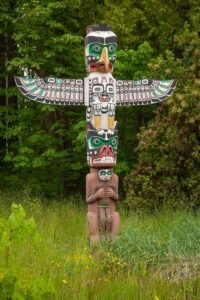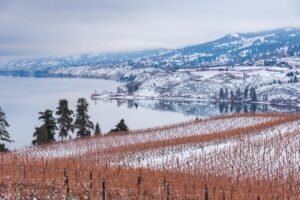Haida Gwaii stands out as a treasure trove of culture and nature on Canada’s rugged northwest coast. Known for its ancestral Haida heritage and distinct ecosystems, these islands allure visitors with stories etched in totem poles and wildlife unique to the region. Find out how Haida Gwaii’s deep legacy and ecological diversity make it an extraordinary place to visit, and what experiences you can anticipate in this guide to Canada’s hidden archipelago gem.
Key Takeaways
-
Haida Gwaii, named in honor of its indigenous Haida people, is an archipelago with a rich cultural and natural history, where the Haida Nation is actively preserving their sovereignty, culture, and environmental heritage.
-
The islands are characterized by a unique ecosystem with endemic wildlife, earning them the nickname ‘Canada’s Galapagos’, and are a haven for nature enthusiasts interested in experiences like birdwatching and whale watching.
-
Visitors to Haida Gwaii can immerse themselves in Haida culture through places like the Haida Heritage Centre, enjoy a multitude of adventure activities such as hiking and kayaking, and can choose from various accommodations and dining experiences that cater to different preferences and budgets.
Exploring the Rich History of Haida Gwaii
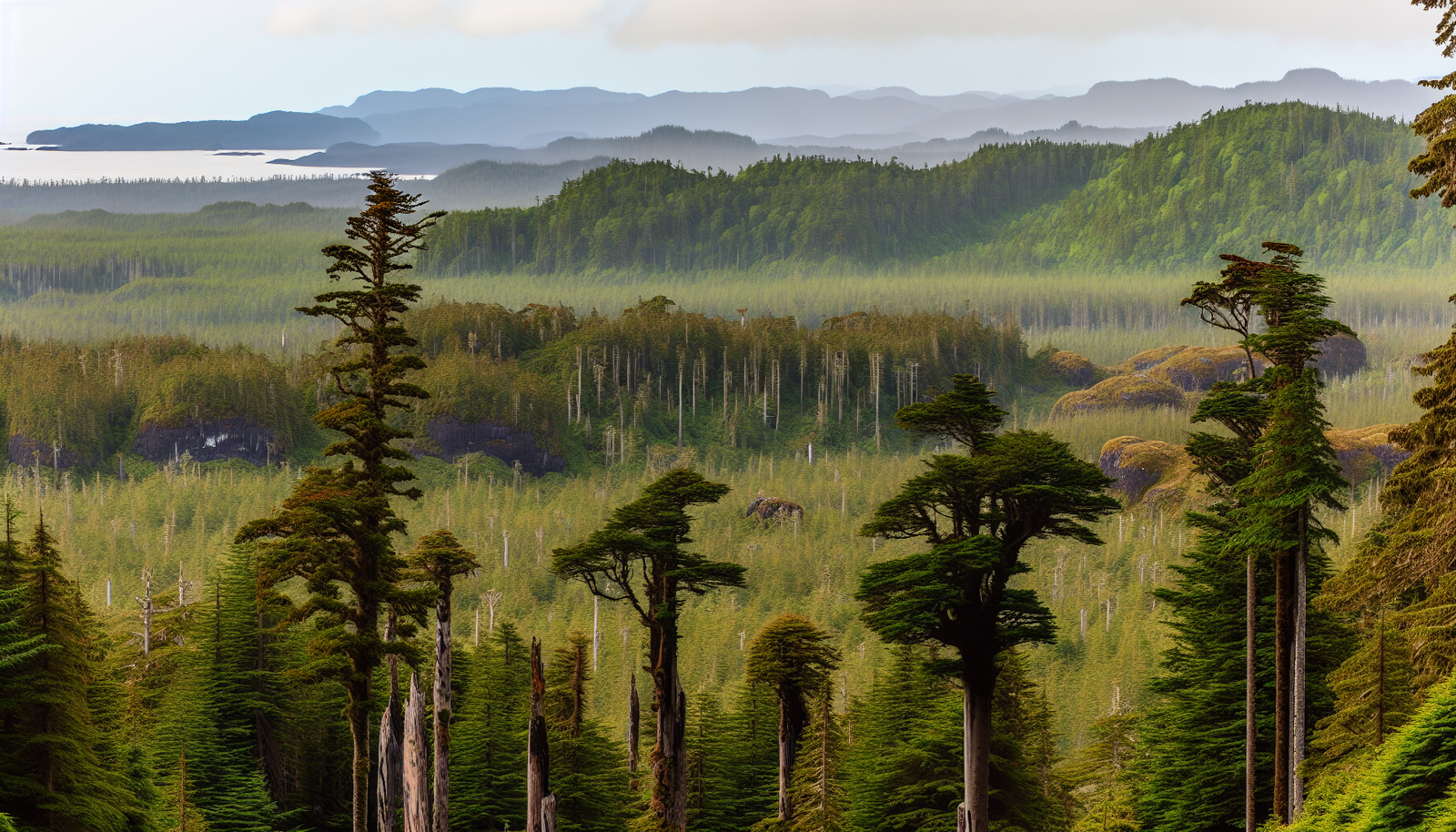
Upon setting foot on Haida Gwaii, one is transported back in time amidst the echoes of ancient civilizations that resonate in the lush rainforests and rugged coastline. This archipelago, officially named in 2010 in recognition of the Haida people who have inhabited these islands for over 14,000 years, offers a rich tapestry of history just waiting to be unraveled.
Pre-colonial era
The Haida people flourished on these islands, long before the arrival of the first Europeans. Archaeologists believe that the islands might have been a pathway for the first human migration to the Americas from the Bering Strait. With a population in the tens of thousands, the Haida established several dozen towns dispersed throughout the islands, living in harmony with the rich natural resources of their homeland.
The echoes of this pre-colonial era are still palpable today in the preserved cultural landscapes of the Gwaii Haanas National Park Reserve, also known as the islands of the people, offering a window into 12,000 years of human habitation.
Colonial era
Haida Gwaii underwent dramatic transformations during the colonial era. European explorers sighted the islands for the first time in the 18th century, marking the beginning of a tumultuous period. The maritime fur trade era saw the Haida fiercely defending their territory, even sinking American trading vessels. However, epidemics introduced by European contact decimated the Haida population, shrinking it to just 350 by the early 1900s.
Despite these challenges, the Haida culture endured, as evidenced by the ruins of SGang Gwaay, a village occupied until shortly after 1880. Its remaining totem poles and longhouses stand today as a unique testament to the power and artistry of Haida society.
Modern times
The Haida Nation has made substantial progress in recent times, including:
-
Asserting their sovereignty
-
Safeguarding their environment
-
The Council of the Haida Nation acting as the government for Haida Gwaii, reflecting the persistent fight for self-governance.
The Haida Nation’s efforts to protect their relationship with their environment and maintain cultural health are evident in their pursuit of legal recognition of their Aboriginal title. Recognizing the challenges faced due to the near extinction of the Haida from colonial impacts, initiatives such as the GayG̱ahlda “Changing Tide” framework and treaty signing with the Heiltsuk Nation in 2015 have been pivotal in the modern reconciliation process.
The Unique Environment and Wildlife of Haida Gwaii
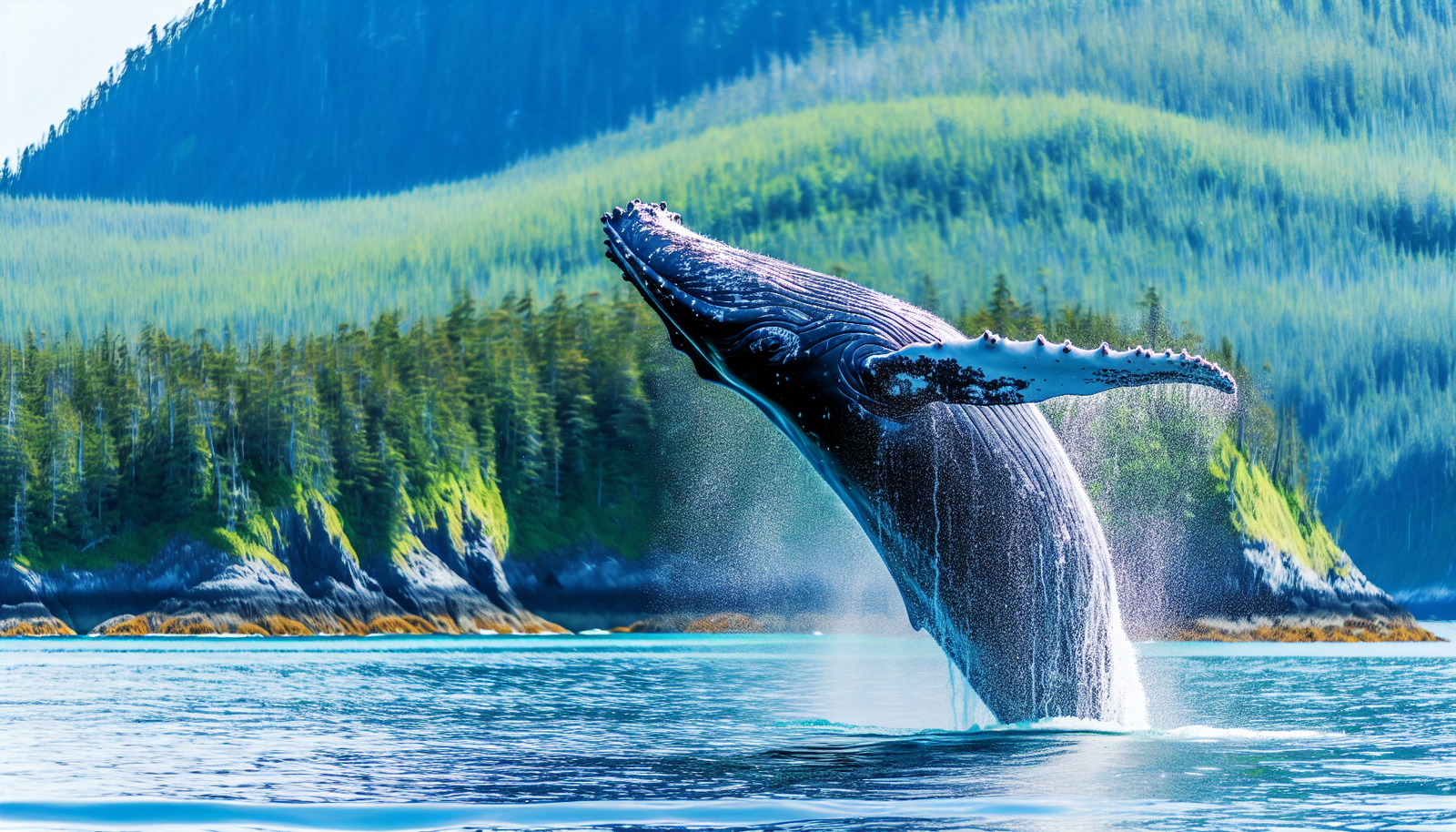
The unique environment and wildlife of Haida Gwaii epitomize the resilience and splendor of nature. The Haida Nation’s active preservation efforts protect the islands’ ecosystems from threats such as increased shipping traffic.
From the cool and humid microclimate indicative of the region’s dense rainforests, to the towering Sitka spruces that form part of the island’s unique flora, Haida Gwaii truly is a paradise for nature enthusiasts.
Endemic species
The isolation of Haida Gwaii has given rise to the evolution of unique endemic species that are found nowhere else in the world. Birdwatchers will be delighted with the endemic bird species such as the pine grosbeak, sooty song sparrow, and northern saw-whet owl, among others.
Mammal enthusiasts, on the other hand, can look out for the six subspecies of land mammals that are native and exclusive to the islands, including the Haida ermine and the dusky shrew.
Wildlife encounters
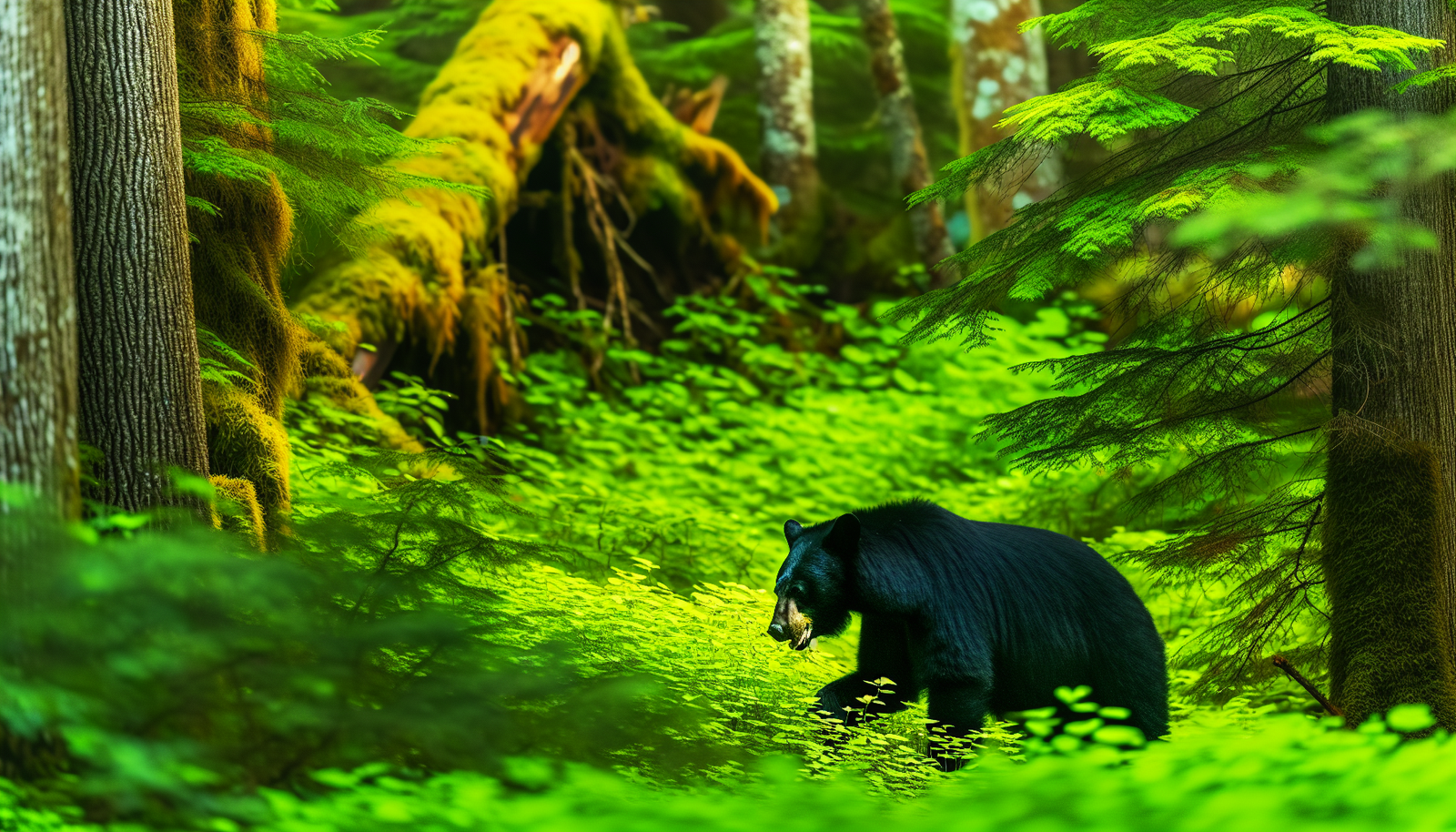
Encountering wildlife in Haida Gwaii is an extraordinary experience. The islands host a variety of endemic bird species and land mammals found nowhere else. Opportunities for wildlife viewing include:
-
Birdwatching: Haida Gwaii is home to a diverse range of bird species, including at-risk species like the ancient murrelet.
-
Whale watching: Gray and humpback whales migrate through the region annually, providing excellent opportunities for whale watching.
-
Black bear sightings: The Haida Gwaii black bear, the largest black bear in North America, can be spotted on the islands.
-
Seabird colonies: The Gwaii Haanas area is home to 1.5 million seabirds, offering a chance to see these fascinating creatures up close.
These wildlife encounters make Haida Gwaii a truly unique destination for nature lovers, with the World Wildlife Fund playing a crucial role in preserving this rich ecosystem.
An exploration of Haida Gwaii is not complete without encountering its abundant wildlife, from bald eagles to breaching whales and sea lions.
Haida Gwaii as the “Galapagos of the North”
The title ‘Canada’s Galapagos’ is a testament to Haida Gwaii’s rich biodiversity and unique ecosystems. Much like the Galapagos Islands, Haida Gwaii’s isolation has led to the evolution of distinct species, making it a hotspot for biologists and nature enthusiasts alike.
Areas of Haida Gwaii that escaped glaciation have given rise to a distinctive ecological landscape, including vibrant intertidal zones and ancient coral forests. With over 6,800 species of flora and fauna inhabiting diverse landscapes, from lush temperate rainforests to dynamic marine habitats, Haida Gwaii truly is the ‘Galapagos of the North’.
Experiencing Haida Culture
Delving into Haida culture enriches one’s understanding of the people’s deep-rooted connection to their land. The renaming of the Queen Charlotte Islands to Haida Gwaii in 2010 was a significant acknowledgment of the indigenous Haida people’s connection to their homeland.
Younger generations of the Haida community are now being taught traditional Haida values and culture through initiatives like the Haida Gwaii Rediscovery program. The Haida Heritage Centre serves as a pivotal institution for the Haida people to share their voice and is devoted to celebrating and preserving their culture, language, art, and narratives.
Haida language
Despite its current classification as endangered, the Haida language remains a vital component of Haida culture. With only 24 native speakers remaining, there is a significant effort to revitalize the language for future generations. Spoken on Haida Gwaii and on Prince of Wales Island in Alaska, the language features a complex sound system and distinctive dialects.
While the language’s classification remains a subject of debate among linguists, its importance to the Haida people is unquestionable. Today, modern efforts to revitalize the Haida language include community classes, academic programs, and the creation of digital language learning applications.
Visual arts and totem poles
Haida culture’s visual arts, particularly the totem poles, mirror their historical ties and connection to their land. Totem poles are monuments created by the First Nations of the Pacific Northwest to represent and commemorate:
-
ancestry
-
histories
-
people
-
events
They are typically carved from red cedar and feature symbolic human, animal, and supernatural forms.
Despite the prohibition of speaking Haida in residential schools and the subsequent diminishment of its use, the traditional carving of totem poles was revitalized after the discriminatory legislation was repealed in 1951, leading to the rise of renowned artists like Bill Reid.
Haida Heritage Centre
The Haida Heritage Centre at Ḵay ‘Llnagaay includes multiple facilities such as:
-
Haida Gwaii Museum
-
Performance House
-
Carving Shed
-
Canoe House
-
Bill Reid Teaching Centre
-
Two multipurpose classrooms
Opened in 2007, the Port Clements Centre is architecturally designed to mirror a traditional oceanside Haida village on the west coast and is a cornerstone for cultural preservation and education.
Master carvers such as:
-
Norman Price
-
Garner Moody
-
Guujaaw
-
Jim Hart
-
Tim Boyko
-
Giitsxaa
Along with their apprentices, have worked on totem poles at the Centre, ensuring the transmission of Haida artistic knowledge and skills across generations.
Planning Your Trip to Haida Gwaii
Organizing your journey to Haida Gwaii is an thrilling undertaking. With so much to see and do, it’s important to consider the best time to visit, how to get there, and what to pack. With the right planning, your trip to Haida Gwaii can be a memorable adventure that leaves you with a deep appreciation for the Haida people and the natural beauty of their lands.
When to go
You can experience the most favorable weather conditions in Haida Gwaii during the following times:
-
June to mid-September: optimal time for a visit
-
May: opportunities for birdwatching, including witnessing eagle cartwheel displays and the return of hummingbirds
-
June: oceans come alive with wildlife like whales, sea lions, and seabirds due to the gathering of baitfish
While July and August offer warmer weather, they also bring more tourists to the area. For a more private experience, consider visiting in September, when salmon runs attract seals, bears, eagles, and sea lions.
How to get there
The journey to Haida Gwaii itself contributes to the overall adventure. You can choose to:
-
Fly into Sandspit from Vancouver International Airport and then take a short ferry ride to Skidegate
-
Take a daily flight from Vancouver to Masset, which is a 2-hour drive to Queen Charlotte City
-
Use floatplane services through Inland Air, providing routes between Prince Rupert and both Masset and Queen Charlotte City
For a more scenic journey in British Columbia, consider taking the BC Ferries service from Skidegate to Prince Rupert, or for an in-depth experience, consider traveling to Haida Gwaii via a small sailboat, while also exploring the beauty of Vancouver Island.
What to pack
Given the variable weather conditions and numerous outdoor activities, packing for a Haida Gwaii trip calls for thoughtful planning. Here are some essential items to pack:
-
Reliable layered clothing to handle the cool climate and frequent rain
-
Waterproof gear to stay dry
-
Waterproof footwear for outdoor activities
-
Sun protection to protect your skin
-
Portable power bank for electronic devices
By packing these items, you’ll be prepared for the weather and able to enjoy your outdoor activities on the islands.
Furthermore, a first aid kit with essential medicines, a wristband for motion sickness, and a rain cover for backpacks and rolling suitcases are recommended.
Adventure Activities in Haida Gwaii
Haida Gwaii promises a wealth of adventure. Whether you’re an avid hiker, a keen kayaker, or a sailing enthusiast, Haida Gwaii offers a variety of activities to quench your thirst for adventure.
From well-maintained hiking trails that traverse through diverse landscapes to waters teeming with marine life near the continental shelf, let’s explore the options.
Hiking trails
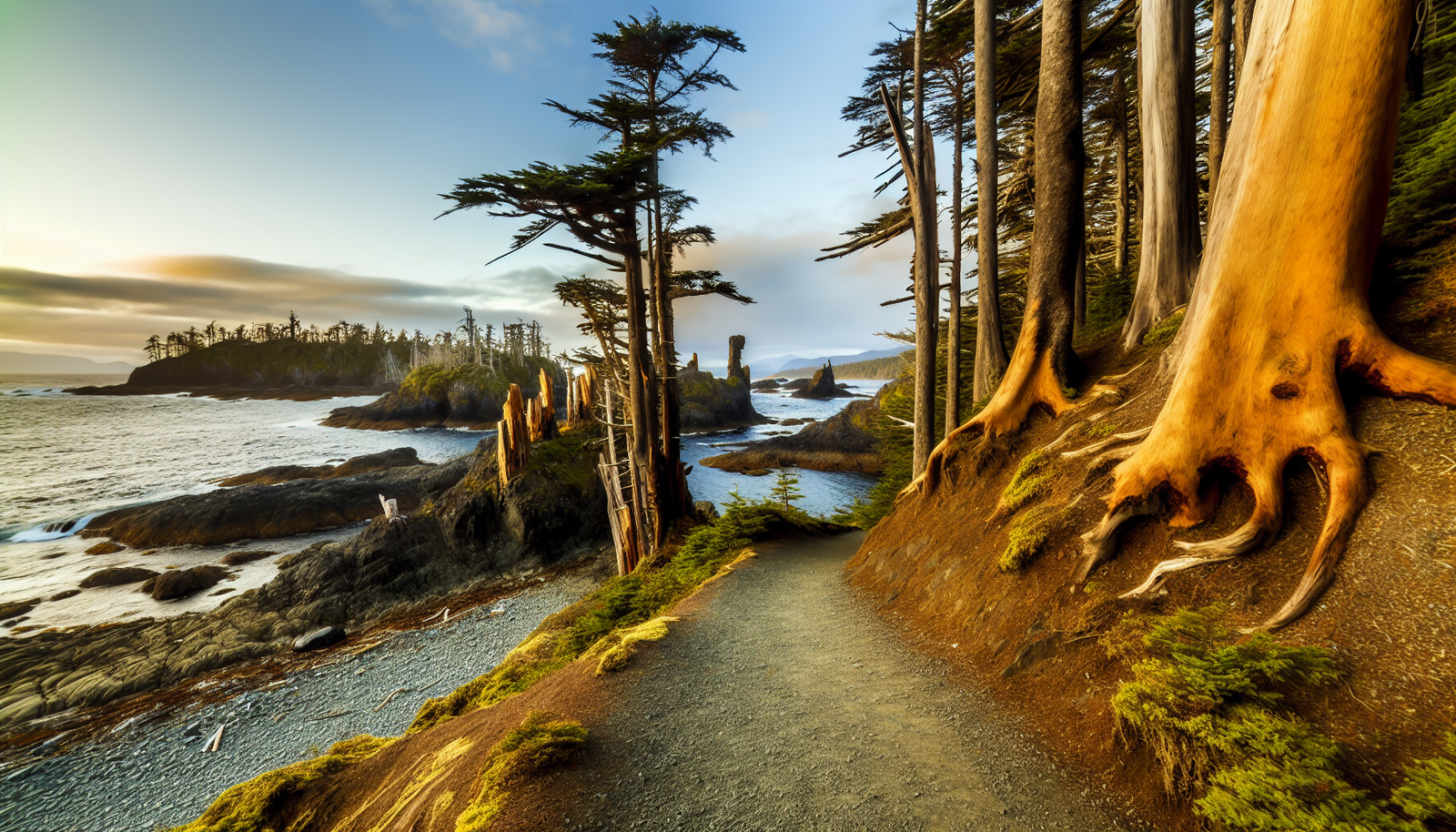
With destinations ranging from breathtaking mountaintops and serene lakes to historic shipwrecks, Haida Gwaii’s hiking trails cater to a variety of hiking interests on the northwest coast. Some trails also lead to beautiful beaches that can be explored at low tide, offering a balanced experience between forest and ocean landscapes near the Hecate Strait.
The Tow Hill trail, for example, provides hikers with exceptional views of the ocean and unique rock formations, adding a distinctive element to the hiking experience. Remember, the trails can be muddy and slippery, especially after rain, so always wear appropriate footwear.
Kayaking adventures
Kayaking in Haida Gwaii provides a close and personal encounter with both nature and Haida culture. Here are some highlights of the experience:
-
Paddle through the waters of Gwaii Haanas National Park
-
Encounter wildlife such as sea lions and humpback whales
-
View brightly colored sea stars in the tidal shallows
-
Experienced guides lead multi-day kayak camping journeys
-
High-quality equipment and freshly prepared meals are provided
Often these expeditions include visits to significant Haida cultural sites such as SGang Gwaay (Ninstints). Some tour operators even specialize in kayak mothershipping, where kayaks are transported to prime locations aboard a larger vessel.
Sailing expeditions
Setting sail on Haida Gwaii’s waters is an unparalleled experience. Sailing expeditions provide an intimate way to explore the region’s pristine wilderness, including access to ancient Haida villages and exposure to an array of wildlife activities. During these tours, participants often encounter marine wildlife such as killer whales, seals, sea lions, humpback whales, and gray whales.
Expeditions are conducted on specialized sailing vessels, featuring private cabins, hot showers, and amenities designed for comfort and exploration. Crews are typically composed of experienced sailors and naturalists who provide valuable insights into the ecology of the area.
Exploring Gwaii Haanas National Park Reserve
Situated in the remote southern region of Haida Gwaii, Gwaii Haanas National Park Reserve bears immense cultural significance for the Haida people. This protected area encapsulates the significant SGang Gwaay, a UNESCO World Heritage Site, and is home to significant Haida village sites, offering a chance to delve deeper into the history and culture of the Haida people.
UNESCO World Heritage Site
As a UNESCO World Heritage Site, SGang Gwaay provides a unique insight into the history and craftsmanship of the Haida on Graham Island. The village features weathered poles and longhouse remains that are integral to Haida history and are accessible through kayaking tours and sailing expeditions.
The natural boundaries of the island preserve SGang Gwaay’s cultural elements, ensuring its protection under the Haida Nation’s constitution and the Canada National Parks Act.
Haida village sites
The Haida Gwaii Watchmen program brings traditional Haida culture to life at five island village sites. These site guardians and guides enhance the management and cultural significance of these village sites in Gwaii Haanas, sharing knowledge of traditional culture with visitors.
The sacred sites guarded by the Haida Gwaii Watchmen, including T’aanuu Llnagaay (Tanu), K’uuna Llnagaay (Skedans), and Gandll K’in Gwaay.yaay (Hotspring Island), offer a deeper understanding of the Haida culture and history.
Guided tours and expeditions
The guided tours and expeditions in Gwaii Haanas provide an all-encompassing experience, covering important cultural and natural landscapes, including:
-
The UNESCO World Heritage Site, SGang Gwaay
-
Access to remote locations
-
Kayak rentals
-
Educational experiences centered around respect for nature and the Haida culture
These tours are facilitated by licensed operators who provide a range of services.
From short day trips by motorboat to extensive sailing expeditions and sea kayaking adventures, there is a tour option to suit every adventurer’s preference.
Accommodations and Dining in Haida Gwaii
After a day filled with exploration and adventure, it’s essential to unwind with a good meal and a restful night’s sleep. Haida Gwaii’s culinary scene offers a range of dining experiences, accommodating a broad palette with options like:
-
fresh seafood
-
varied Asian cuisines
-
cozy cafes
-
casual pubs
Whether you’re looking for luxury lodges with spa services or budget-friendly options, there’s accommodation to suit all preferences and budgets.
Lodging options
A variety of accommodations are available in Haida Gwaii, tailored to suit different preferences and budgets. From luxury lodges offering comprehensive spa services to more affordable budget accommodations, there’s something for everyone.
While there is no public transit, shuttle services between airports and communities are available, and car rentals can be arranged for greater travel flexibility on the islands.
Local cuisine and dining experiences
Just like its natural surroundings, the culinary landscape of Haida Gwaii is diverse and vibrant. Gourmet dining options featuring local ingredients like wild chantrel mushrooms and herring roe can be found at establishments such as Blacktail Restaurant and Haida House at Tllaal Dining Room. For a more casual dining experience, consider Charters Food Truck, Ocean View Restaurant, or The Axe & Anchor Pub.
Budget-conscious travelers will appreciate affordable options like The Ground Gallery & Coffee House and The 626 Fish And Chipper.
Summary
In conclusion, Haida Gwaii is a destination like no other. Its rich history, unique environment, and vibrant Haida culture make it a must-visit for history buffs, nature enthusiasts, and those looking for a culturally immersive experience. Whether you’re exploring the ancient Haida village sites, hiking through lush rainforests, or sailing the pristine waters, Haida Gwaii offers an unforgettable journey of discovery. So, are you ready to embark on your Haida Gwaii adventure?
Frequently Asked Questions
What is so special about Haida Gwaii?
Haida Gwaii is special because of its diverse plant and animal life, monumental poles and longhouses, dramatic landscapes, abundant wildlife, and rich heritage, including more than 500 archeological sites. It’s nicknamed Canada’s Galapagos due to its uniqueness and is a great place for learning and exploration.
Does anyone live in Haida Gwaii?
Yes, Haida people make up over half of the 4200 inhabitants of Haida Gwaii, and they reside throughout the islands with concentrations in two main centers.
Is it worth going to Haida Gwaii?
Yes, it is worth going to Haida Gwaii for its diverse plant and animal life, monumental poles, longhouses, dramatic landscapes, abundant wildlife, and rich heritage. You will have the opportunity to explore over 500 archaeological sites and learn something new for everyone.
What is the best month to visit Haida Gwaii?
The best month to visit Haida Gwaii is May because it offers the most hours of sunlight, despite cooler temperatures, while the weather is generally cool and wet in any month.
How can I reach Haida Gwaii?
You can reach Haida Gwaii by taking a flight to Sandspit from Vancouver International Airport and then a short ferry ride to Skidegate. Another option is to take a floatplane from Prince Rupert or sail to Haida Gwaii.

